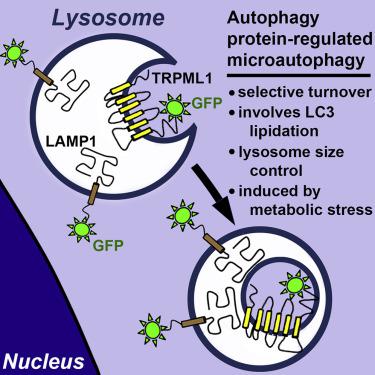Developmental Cell ( IF 10.7 ) Pub Date : 2020-09-10 , DOI: 10.1016/j.devcel.2020.08.008 Chan Lee 1 , Lilian Lamech 2 , Eleanor Johns 3 , Michael Overholtzer 4

|
Lysosome function is essential for cellular homeostasis, but quality-control mechanisms that maintain healthy lysosomes remain poorly characterized. Here, we developed a method to measure lysosome turnover and use this to identify a selective mechanism of membrane degradation that involves lipidation of the autophagy protein LC3 onto lysosomal membranes and the formation of intraluminal vesicles through microautophagy. This mechanism is induced in response to metabolic stress resulting from glucose starvation or by treatment with pharmacological agents that induce osmotic stress on lysosomes. Cells lacking ATG5, an essential component of the LC3 lipidation machinery, show reduced ability to regulate lysosome size and degradative capacity in response to activation of this mechanism. These findings identify a selective mechanism of lysosome membrane turnover that is induced by stress and uncover a function for LC3 lipidation in regulating lysosome size and activity through microautophagy.
中文翻译:

营养饥饿诱导选择性溶酶体膜周转。
溶酶体功能对于细胞稳态至关重要,但维持健康溶酶体的质量控制机制仍然缺乏表征。在这里,我们开发了一种测量溶酶体周转的方法,并使用它来确定膜降解的选择性机制,该机制涉及自噬蛋白 LC3 脂化到溶酶体膜上以及通过微自噬形成腔内囊泡。这种机制是响应由葡萄糖饥饿引起的代谢应激或通过用诱导溶酶体渗透压的药物治疗而诱导的。缺乏 ATG5(LC3 脂化机制的重要组成部分)的细胞显示调节溶酶体大小和降解能力的能力降低,以响应该机制的激活。











































 京公网安备 11010802027423号
京公网安备 11010802027423号